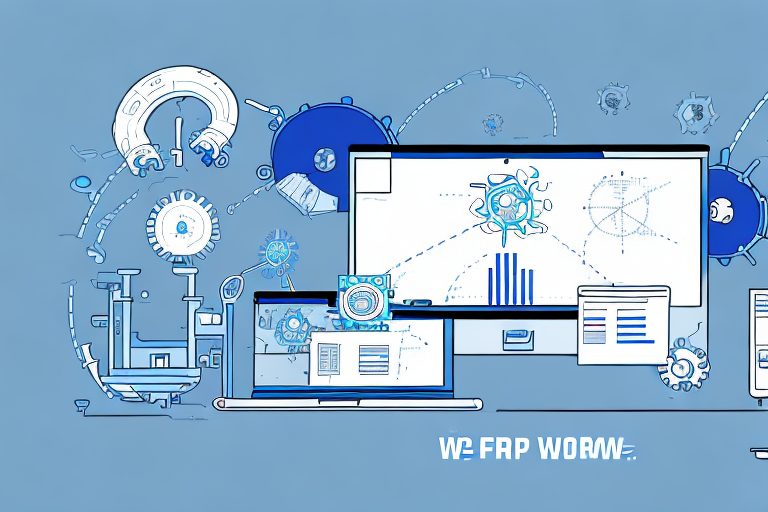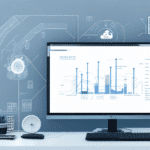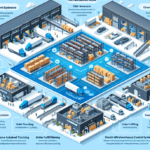Choosing the Right Warehouse Management Solution for Your Business
Selecting the appropriate warehouse management system (WMS) is crucial for optimizing your business operations. With a plethora of options available, comparing features and capabilities is essential to find the best fit. This article provides an in-depth comparison of two leading solutions: SAP Extended Warehouse Management (EWM) and Infor CloudSuite WMS. We will explore their functionalities, advantages, disadvantages, and user experiences to help you make an informed decision.
Understanding SAP Extended Warehouse Management (EWM)
SAP EWM is a comprehensive warehouse management system designed to provide businesses with real-time visibility and control over their warehouse operations. It aids in optimizing inventory management, streamlining logistics processes, and enhancing supply chain efficiency through end-to-end process visibility.
- Complex Operations Handling: Supports cross-docking, wave picking, and slotting.
- Advanced Inventory Management: Features cycle counting, physical inventory, and stock transfers.
- Highly Configurable: Tailors to specific industry needs and integrates seamlessly with other SAP solutions like SAP Transportation Management.
According to a Gartner report, SAP EWM is recognized for its robust capabilities in managing large-scale warehouse operations.
Exploring Infor CloudSuite WMS
Infor CloudSuite WMS is a cloud-based warehouse management solution tailored for small to midsize businesses. It automates essential warehouse tasks such as receiving, put-away, picking, and shipping, thereby enhancing efficiency and reducing operational costs.
- Real-Time Visibility: Tracks inventory levels and monitors order statuses effectively.
- Advanced Reporting and Analytics: Facilitates data-driven decision-making through comprehensive insights.
- Scalability and Flexibility: Customizable to adapt to evolving business requirements.
Independent research by Forrester highlights Infor CloudSuite WMS for its ease of use and rapid deployment capabilities.
Comparative Analysis: SAP EWM vs. Infor CloudSuite WMS
When evaluating SAP EWM and Infor CloudSuite WMS, several factors come into play:
- Customization: SAP EWM offers extensive customization, ideal for complex operations, while Infor CloudSuite WMS provides a more standardized solution suitable for simpler implementations.
- Integration: SAP EWM integrates seamlessly within the SAP ecosystem, enhancing its comprehensive supply chain management. In contrast, Infor CloudSuite WMS integrates well within Infor’s suite but may require additional efforts for third-party integrations.
- Implementation Costs: SAP EWM tends to be more expensive and time-consuming to implement compared to the more cost-effective and quicker deployment of Infor CloudSuite WMS.
Choosing between the two largely depends on your organization's size, complexity of operations, and budget constraints.
Key Features of SAP Extended Warehouse Management (EWM)
- Real-Time Inventory Visibility: Provides up-to-the-minute data on inventory and warehouse operations.
- Advanced Automation: Streamlines processes through automation, reducing manual intervention.
- Shipping and Transportation Planning: Enhances logistics planning and execution.
- Flexible Integration: Easily integrates with other SAP systems for a unified approach.
- Enhanced Labor Management: Optimizes workforce productivity and efficiency.
- Advanced Slotting: Efficiently allocates warehouse space based on demand and product characteristics.
These features not only improve operational efficiency but also contribute to significant cost savings. A study by ProductionHub reports that businesses using SAP EWM experience up to a 20% increase in warehouse efficiency.
Key Features of Infor CloudSuite WMS
- Cloud-Based Accessibility: Accessible from any device with an internet connection, facilitating remote management.
- Automated Processes: Enhances accuracy and efficiency in receiving, picking, and shipping.
- Built-In Analytics: Provides actionable insights for informed decision-making.
- Flexible Integration: Integrates with other Infor products to streamline operations.
- Mobile Application: Enables warehouse workers to perform tasks on-the-go, increasing productivity.
According to Software Advice, Infor CloudSuite WMS is praised for its user-friendly interface and robust mobile capabilities.
Pros and Cons of SAP EWM
Pros
- Comprehensive management capabilities for large warehouses.
- Advanced integration with other SAP products.
- Real-time visibility and control over operations.
Cons
- Steep learning curve for new users.
- High implementation and maintenance costs.
- Requires specialized IT expertise for customization.
Despite its high costs and complexity, SAP EWM remains a popular choice for enterprises seeking robust warehouse management solutions. Its ability to handle intricate operations and integrate seamlessly with other SAP modules makes it a valuable asset for large-scale businesses.
Pros and Cons of Infor CloudSuite WMS
Pros
- Cloud-based accessibility allows for flexible management.
- Easy setup and user-friendly interface.
- Flexible integration with other Infor products.
Cons
- Less suitable for very large warehouse operations.
- Limited customization outside Infor’s platform.
- Reporting functionalities are not as advanced as those in SAP EWM.
Infor CloudSuite WMS is ideal for small to midsize businesses looking for a cost-effective and easily deployable warehouse management solution. Its ease of use and cloud-based nature make it accessible, though it may lack some advanced features required by larger enterprises.
Integration Capabilities
SAP EWM Integration
SAP EWM excels in integrating within the SAP ecosystem, allowing seamless connectivity with SAP ERP, SAP S/4HANA, and other SAP modules. This integration facilitates a unified supply chain management approach, enhancing visibility and collaboration. However, integrating with third-party systems may require advanced programming skills and increased IT support, potentially raising implementation costs.
Infor CloudSuite WMS Integration
Infor CloudSuite WMS offers robust integration within the Infor product suite, including CRM, ERP, and HCM systems. This ensures a cohesive workflow across different business functions. However, integration with external systems is more limited compared to SAP EWM, often relying on Infor’s pre-built connectors.
Implementation Process and Costs
Implementing SAP EWM
Deploying SAP EWM is a resource-intensive process that can take several months. It involves extensive customization and complex integrations, necessitating significant IT expertise and support. Implementation costs can range from several hundred thousand to several million dollars, depending on the organization's size and project scope.
Implementing Infor CloudSuite WMS
Infor CloudSuite WMS offers a more streamlined implementation process, typically completed faster and at a lower cost compared to SAP EWM. Being cloud-based, it reduces the need for extensive hardware and IT infrastructure. Implementation costs generally range from a few thousand to several hundred thousand dollars, making it accessible for smaller businesses.
User Experience
SAP EWM User Experience
SAP EWM provides a powerful and comprehensive platform for managing complex warehouse operations. However, its steep learning curve and intricate interface may pose challenges for users with limited IT backgrounds. Adequate training and support are essential to leverage its full potential.
Infor CloudSuite WMS User Experience
Infor CloudSuite WMS is designed with user-friendliness in mind. Its intuitive interface and minimal IT requirements make it easy for employees to learn and use effectively. The mobile application further enhances usability, allowing workers to manage tasks efficiently from any location within the warehouse.
Future Developments
Future of SAP EWM
SAP EWM continues to evolve with each new release, focusing on enhancing user experience and reducing implementation complexities. Recent updates aim to improve usability and accessibility, making it more adaptable to a broader range of business sizes.
Future of Infor CloudSuite WMS
Infor CloudSuite WMS is regularly updated to address the dynamic needs of the logistics industry. Recent enhancements emphasize advanced reporting and analytics, empowering businesses with deeper insights for optimizing warehouse operations and reducing costs.
Making the Right Choice for Your Business
The decision between SAP EWM and Infor CloudSuite WMS hinges on various factors including the scale and complexity of your warehouse operations, budget, and growth trajectory. SAP EWM is best suited for large enterprises requiring comprehensive capabilities and advanced integrations within the SAP ecosystem. On the other hand, Infor CloudSuite WMS is ideal for small to midsize businesses seeking an affordable, easy-to-implement solution that enhances warehouse efficiency without the need for extensive customization.
Conclusion
Choosing the right warehouse management system is pivotal for improving supply chain performance and operational efficiency. Both SAP EWM and Infor CloudSuite WMS offer robust solutions tailored to different business needs. By carefully assessing your organization's specific requirements, budget constraints, and future growth plans, you can select the WMS that best aligns with your strategic objectives.






















